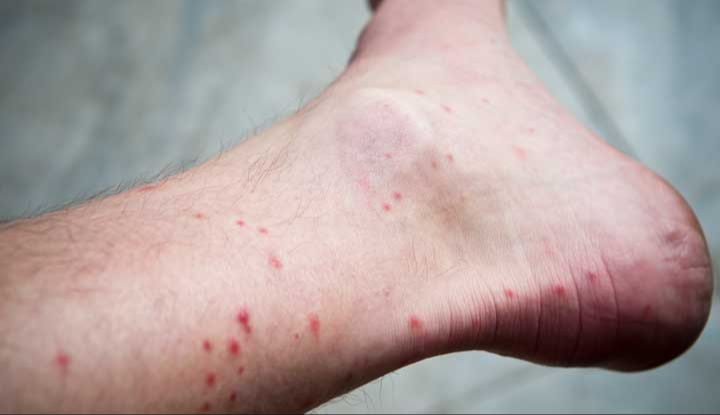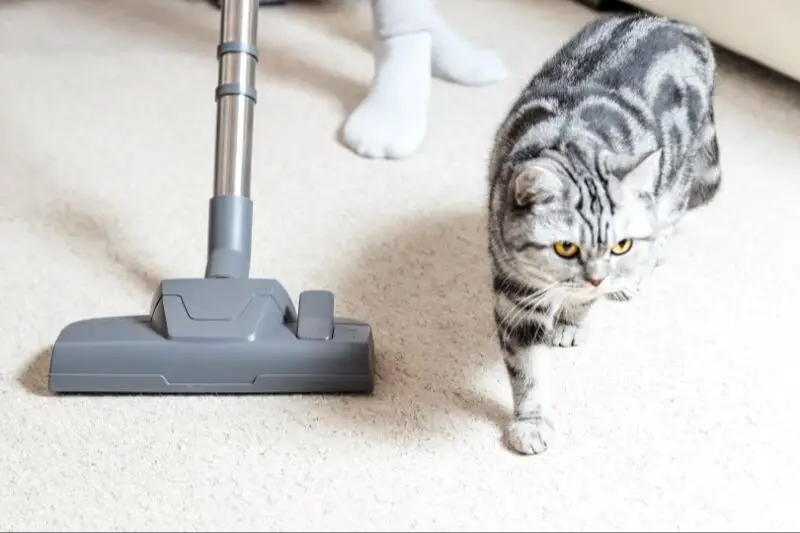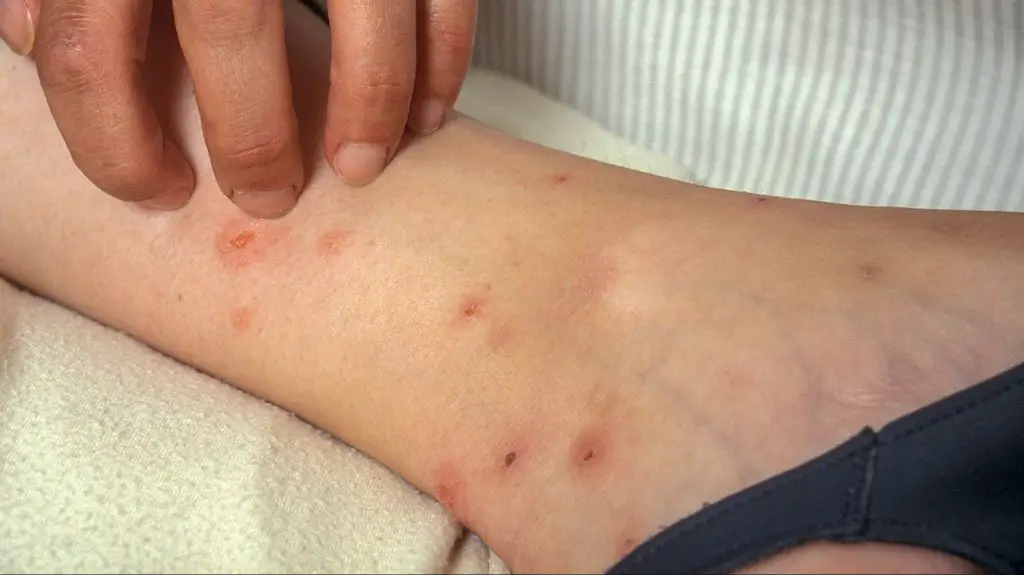Cat fleas are tiny wingless insects that live as external parasites on cats. The scientific name for the common cat flea is Ctenocephalides felis. Cat fleas feed on cat blood and can cause irritation, itching, inflammation, and discomfort. Although cat fleas prefer and are adapted to feeding on cat blood, they sometimes bite and live on humans as well. This brings up the question of whether cat fleas can transfer from cats to humans.
This article will examine the possibility of cat fleas spreading from cats to humans. It will cover topics such as cat flea bites on humans, diseases they can transmit, prevention methods, and treatment options. Information will be provided to help pet owners understand the health risks regarding cat fleas and how to protect both feline and human family members.
Can Cat Fleas Live on Humans?
Cat fleas can live on humans but they cannot reproduce on human blood. The cat flea, Ctenocephalides felis, is the most common flea species found in the United States and prefers feeding on cat or dog blood. However, in the absence of their preferred hosts, cat fleas will readily bite and feed on human blood for survival.
According to Elanco, while cat fleas can temporarily live on humans, they will not stay on human skin long term or lay eggs. Cat fleas can only reproduce after feeding on cat or dog blood. The human body temperature is too low and human blood provides inadequate nutrition for cat fleas to reproduce.
So in summary, cat fleas need cat or dog blood to thrive and reproduce. They may opportunistically bite humans but cannot permanently live on human hosts.

Cat Flea Bites on Humans
Cat flea bites on human skin appear as small, red, raised bumps that often look like spots or dots on the skin. The bumps are very itchy and tend to be concentrated around the ankles and lower legs but can also appear on other areas of the body. Flea bites can be surrounded by a reddish halo or swollen area. They are usually no bigger than a pinpoint but can welt up substantially in people with severe allergies to flea saliva.
According to Cleveland Clinic, flea bites may be confused with other insect bites, rashes or skin conditions. The itchy red bumps can persist for a week or more, and may lead to excessive scratching that causes further skin irritation. Flea bites can feel intensely itchy, often disproportionate to their small size. The itching sensation stems from an allergic reaction to components of flea saliva. Some people experience a burning or prickling sensation when bitten.
Multiple flea bites in a small area can merge to form larger red bumps or swollen patches. In severe flea infestations involving hundreds of bites, the skin may develop crusty sores or scabs from the resulting inflammation and constant scratching. Proper identification and treatment of flea bites is important to curb the itch and prevent skin damage from scratching. If you suspect flea bites, inspect your home and pets thoroughly.
Diseases Cat Fleas Can Transmit to Humans
Cat fleas can carry and transmit several diseases that can infect humans, some of which can be quite serious. Some of the main diseases that cat fleas may transmit to humans include:
- Plague – Cat fleas can transmit plague, including bubonic plague, caused by the bacterium Yersinia pestis. Plague is rare in the U.S. but can be very serious. Symptoms include fever, chills, weakness, and swollen lymph nodes. [1]
- Murine Typhus – Caused by Rickettsia typhi bacteria and transmitted by infected flea feces. Symptoms include fever, rash, headache, chills. [2]
- Bartonellosis (Cat Scratch Disease) – Caused by Bartonella bacteria and transmitted through flea bites. Symptoms are swollen lymph nodes, fever, fatigue. Usually mild. [3]
- Tapeworms – Flea tapeworms can be transmitted to humans if flea larvae are accidentally ingested. Can cause digestive issues. [3]
- Tungiasis – Caused by sand fleas burrowing into skin. Causes itching, swelling, pain. [2]
While rare in areas with modern sanitation and pest control, these flea-borne illnesses show the importance of controlling fleas and preventing flea infestations in your home if you have pets.
[1] https://www.cdc.gov/fleas/diseases.html
[2] https://www.anteaterpestcontrol.com/5-flea-borne-diseases-that-affect-humans
[3] https://www.orkin.com/pests/fleas/flea-diseases
Preventing Cat Fleas from Transferring to Humans
There are several effective ways to prevent cat fleas from infesting your home and biting humans:
- Treat your cat with a monthly topical flea prevention medication like Frontline or Advantage. This will kill fleas on your cat and prevent further infestation (source: https://www.cdc.gov/fleas/avoid/on_people.html).
- Vacuum carpets, floors, and furniture frequently to remove eggs and larvae. Be sure to empty the vacuum contents in a sealed bag afterwards (source: https://www.webmd.com/pets/flea-bites-protect-yourself).
- Wash your pet’s bedding weekly in hot, soapy water to kill any fleas or eggs (source: https://www.wikihow.com/Prevent-Flea-Bites).
- Consider using flea control products like flea collars, sprays, foggers, or powders around your home. Be sure to follow all label instructions carefully.
- Inspect any new pets closely before bringing them home to ensure they are flea-free.
- Keep grass trimmed short around your home and avoid dense brush or woodpiles where fleas can live.

With diligent prevention both on your cat and in your home, you can help stop cat fleas from biting and annoyance humans in the household.
Treating Cat Flea Bites on Humans
If you experience flea bites from your cat, there are several options for treating the bites and relieving itching and inflammation:
Topical creams and ointments can provide relief from itching and swelling. Products containing ingredients like hydrocortisone, pramoxine, and menthol can numb and soothe irritated skin (source). Apply a small amount of cream to each bite as needed.
Oral antihistamines like diphenhydramine (Benadryl) or cetirizine (Zyrtec) can help reduce itching by blocking histamine’s effects. Follow dosage instructions on the package (source).
Cool compresses or ice packs can provide temporary relief and help reduce swelling and inflammation around the bites. Wrap an ice pack in a towel and apply to affected areas for 10-20 minutes as needed (source).
Avoid scratching flea bites as this can lead to infection. Keep fingernails short and clean. Bandages or adhesive tape can protect irritated skin.
See a doctor if irritation persists after a few days or signs of infection appear like oozing, redness, or fever.
Removing Cat Fleas from Your Home
To fully get rid of a flea infestation, you’ll need to treat your home environment in addition to treating your cat. Fleas love to hide in carpets, furniture, bedding and other areas of your home.
Here are some effective methods for removing fleas from your home:
- Vacuum all carpets, floors, furniture and bedding frequently and thoroughly to remove eggs and larvae. Be sure to empty the vacuum contents right away so fleas don’t re-enter your home. According to Healthline, “Use a powerful vacuum on any floors, upholstery, and mattresses. Cracks and other tight spaces are usually good hiding places for fleas and their eggs” [1].
- Use flea sprays, powders, or foggers to kill adult fleas and eggs. Apply these products to all carpets, cracks, furniture and pet bedding. Be sure to follow the manufacturer’s directions closely.
- Consider hiring a professional exterminator to treat your home if the infestation is severe. They have industrial-strength products and methods to eliminate fleas.
- Wash all pet bedding, pillows, curtains, towels, throws, etc. in hot, soapy water to destroy fleas and eggs.
- Clean and vacuum beneath furniture to remove flea eggs and larvae.
With diligent and thorough treatment, you can fully rid your home of fleas. Consistent vacuuming and washing is key. You may need to treat the home multiple times over 2-3 weeks to fully break the flea life cycle.

Treating Your Cat for Fleas
It’s very important to treat your cat for fleas if they have an infestation. Fleas can cause significant irritation, discomfort, and health issues for your cat. They can also spread to you, your family and your home if left untreated.
There are several effective treatment options for getting rid of fleas on your cat:
- Spot-on treatments like Frontline Plus, Advantage II or Cheristin that are applied monthly to the skin on the back of your cat’s neck. These kill adult fleas and prevent new infestations.
- Flea collars like the Seresto collar that provide ongoing flea control for months at a time.
- Flea shampoos and sprays can provide immediate relief by killing many of the adult fleas on your cat during bathing. However, these don’t provide ongoing protection.
- Oral medications like Capstar, which begins working within 30 minutes to kill fleas.
It’s important to treat all pets in your home and follow up with environmental treatment to kill any lingering flea eggs and larvae. Be sure to consult your vet for advice on the safest, most effective flea control methods for your cat.
When to See a Doctor
Most flea bites can be treated at home with over-the-counter medications and home remedies. However, you should see a doctor if you experience any of the following:

- Severe itching or pain that doesn’t improve with self-care after a few days
- Signs of a skin infection, such as redness, swelling, warmth, oozing pus, enlarged lymph nodes
- Allergic reaction symptoms like hives, swelling, or difficulty breathing
- Persistent lethargy, fatigue, fever, or flu-like symptoms, which could signal an infection
- Multiple flea bites covering large areas of the body
- Flea bites on infants younger than 2 months old
See a doctor promptly if you have any severe symptoms or concerning reactions to flea bites. They can examine the bites, test for infections, and provide medications to manage allergic reactions if needed. Quick medical care can help prevent serious complications from developing.
People with weakened immune systems from conditions like HIV/AIDS or cancer treatment should also consult a doctor about flea bites, as they are more prone to infections. Elderly individuals may also want medical advice to ensure proper healing.
In very rare cases, flea-borne typhus or plague could occur after bites. Seek immediate medical care if you develop high fever, severe headaches, muscle pains, chills, or vomiting after flea exposure. Catching these serious but rare infections quickly is vital.
Conclusion
When it comes down to it, cat fleas cannot permanently live on humans. While they may bite humans and cause temporary itching and discomfort, they cannot reproduce on human blood. The flea infestation will die off in a few days without a feline host to feed on. The key points to remember are:
– Cat fleas can bite and live on humans temporarily but will not permanently infest humans.
– Flea bites on humans cause minor itching and irritation, but do not typically transmit diseases.
– Prevent fleas by regularly treating your cat and home for fleas, vacuuming frequently, and washing bedding.
– If bitten by fleas, treat the bites with anti-itch creams, calamine lotion, cold packs, or aloe vera. Avoid scratching.
– See a doctor for severe itching, signs of infection, or potential flea-borne disease transmission.
So in summary, cat fleas can temporarily hop onto and bite humans when dislodged from animal hosts, but they cannot reproduce on human blood. With proper preventative treatment for your pets and home, flea bites on humans can be avoided.
